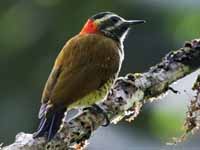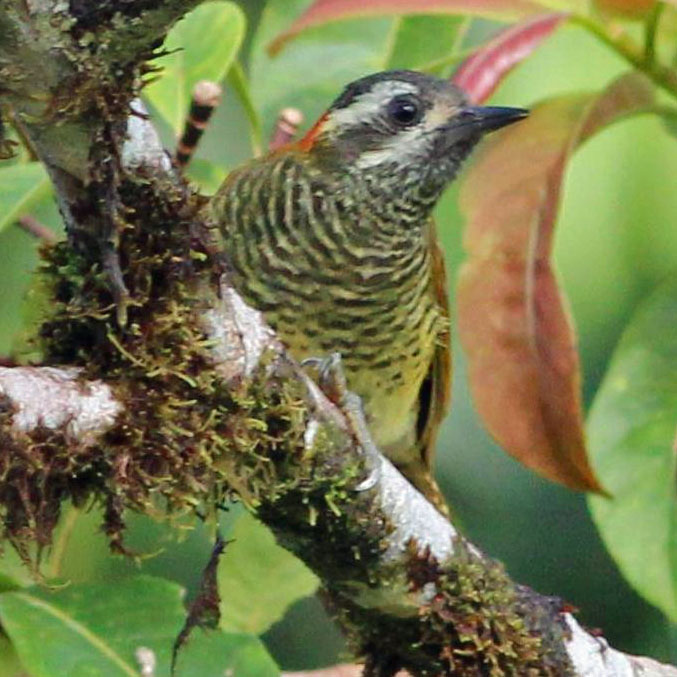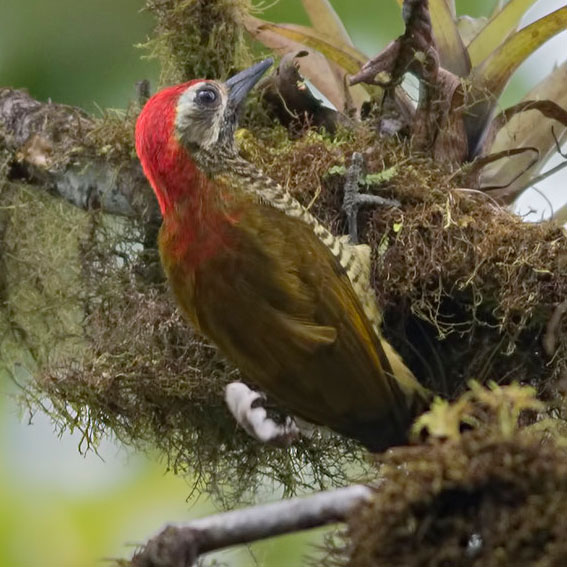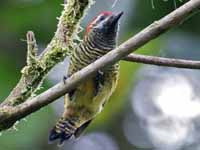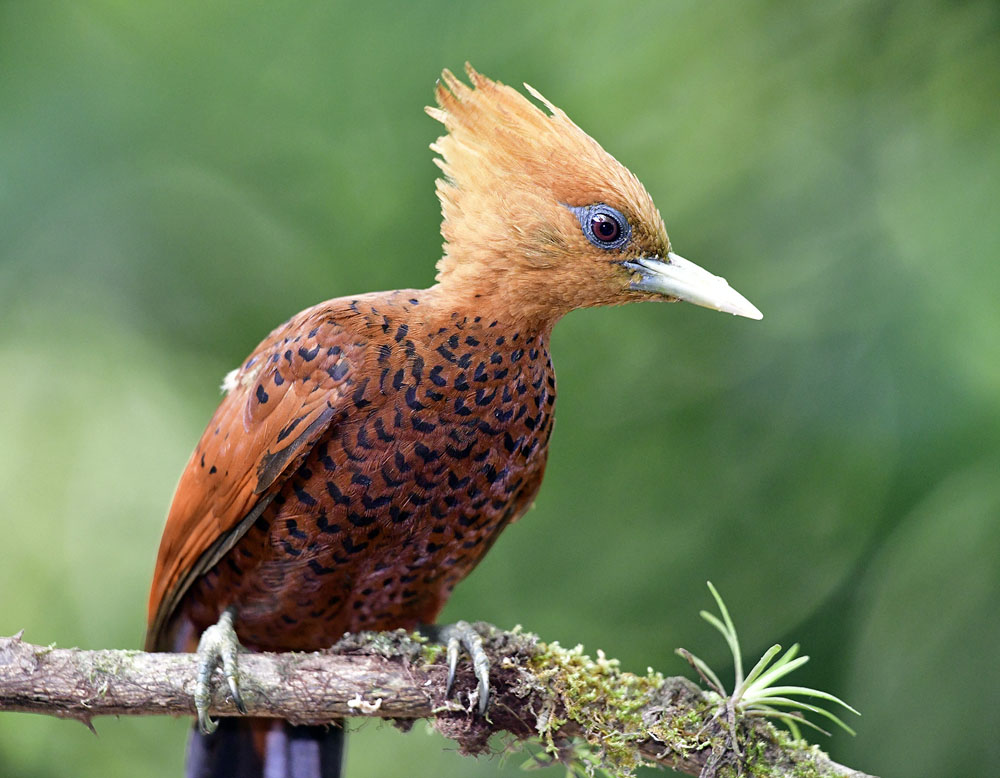The order Piciformes is made up of the woodpecker family Picidae plus 8 other families. Picidae make up about half of the species. In general, the Piciformes are insectivorous, but some exceptions eat mostly fruit. Nearly all Piciformes have parrot-like feet—two toes forward and two back, an arrangement that has obvious advantages for birds that spend much of their time on tree trunks. And most Piciformes do not have down feathers at any age, only true feathers. All nest in cavites.
Family Picidae: Woodpeckers and Allies
The woodpeckers family members are found almost worldwide. Most species live in forests or woodland habitats, although a few species are known to live in treeless areas such as rocky hillsides and deserts. They range in size from 8-50 cm. Many species exhibit patches of red and yellow on their heads and bellies, and these bright areas are important in signalling. Although the sexes of Picidae species tend to look alike, many have more prominent red or yellow head markings in males than in females.
Members of the family Picidae have strong bills for drilling and drumming on trees and long sticky tongues for extracting food. Species that use their bills in soil or for probing as opposed to regular hammering tend to have longer and more decurved bills. To prevent brain damage from the rapid and repeated decelerations, woodpeckers have evolved a number of adaptations to protect the brain. These include small brain size and the short duration of contact. The millisecond before contact with wood a thickened membrane closes, protecting the eye from flying debris. The nostrils are also protected, they are often slit-like and have special feathers to cover them. In addition to the strong claws and feet woodpeckers have short strong legs, this is typical of birds that regularly forage on trunks. The tails of most woodpeckers are stiffened, and when the bird perches on vertical surfaces, the tail and feet work together to support it. Picidae species can either be sedentary or migratory.
There are 7 articles pertaining to the woodpecker family Picidae: African, Eurasian, North America, South America, Small, Large, Terrestrial.
The article describes the South American woodpecker genera Celeus, Piculus, and Veniliornis. Because South America is connected to North America, it is not surprising that some of the species contained in these two general are found in Central America and North America.
The 13 Celeus woodpeckers are often chestnut colored. Their head, including its crest, is often lighter than the body.The male has a red malar stripe which may spread to the cheek. Their favorite foods are ants and termites, plus their larvae. They will also eat fruit. The food is usually obtained in the tree by gleaning and pecking, but some species will forage sometiomes on the ground. The nests are excavated in trees and sometimes in ant or termites nests that are in the tree. The Celeus woodpeckers have lengths varying from 19 t0 30 cm.
There are six species of Piculus woodpeckers. They are are found in Central and South America. Most have olive-green upperparts, barred underparts, and at least the male has red on part of its head. Their favorite food is ants, but they seem to have a more varied insect diet than do the Celeus woodpeckers. All but one species has a length between 17 to 22 cm. The golden-green woodpecker (Piculus chrysochloros) is listed as having a length between 18 and 27 cm, the wide range due to a wide variety of subspecies.
Clements Checklist of THE WORLD BIRDS places all of the Veniliornis species in genus Dryobates, but other sources do not, They are treated here in a seperate genus so that they are not mixed with a multitude of North American species. They are 12 to 19 cm long, which makes them someswhat smaller than the typical Celeus or Piculus woodpecker. Most of the Veniliornis species have olive upperparts and barred underparts. For some species, not much is know about their diet, but because they are only seen foraging for food in trees, they all seem to specialize in insects and occasionally fruit.
More South American woodpecker species are located in other genera. Picumnus contains the piculets and the majority of them are from South America. Colpates contains the flickers and other ground preferring woodpeckers. The largest woodpeckers are found in Campephilus and Dryocopus.
Genus Celeus
Woodpecker,_Blond-crested Celeus flavescens
Description: The blond-crested woodpecker has a blond head with a long crest and yellow throat, It has black upperparts with white edging and black underparts. The male has a red malar stripe. The blond-crested woodpecker is 27 to 30 cm long. The similar female pale-crested woodpecker has brown malar stripe while the female blond-crested woodpecker has a negligible malar stripe. Differentiating between males is problematic, but in general the blond-crested woodpecker has stronger bar-like edging on its back.
Range: Argentina, Brazil, Paraguay.
Habitat: Rainforest, plantations, palm groves, wooded savannah, orchards and gardens.
Diet: Ants, termites, their larvae. Also fruit. It forages mainly in trees, but will come to the ground to look for insects.
Conservation status: Least Concern.
Image by: 1, 4) Dario Sanches- Brazil 2) Nortondefeis 3) Aaron Maizish - Brazil Range: Argentina, Brazil, Paraguay.
Habitat: Rainforest, plantations, palm groves, wooded savannah, orchards and gardens.
Diet: Ants, termites, their larvae. Also fruit. It forages mainly in trees, but will come to the ground to look for insects.
Conservation status: Least Concern.
1, 2) Female 3, 4) Male
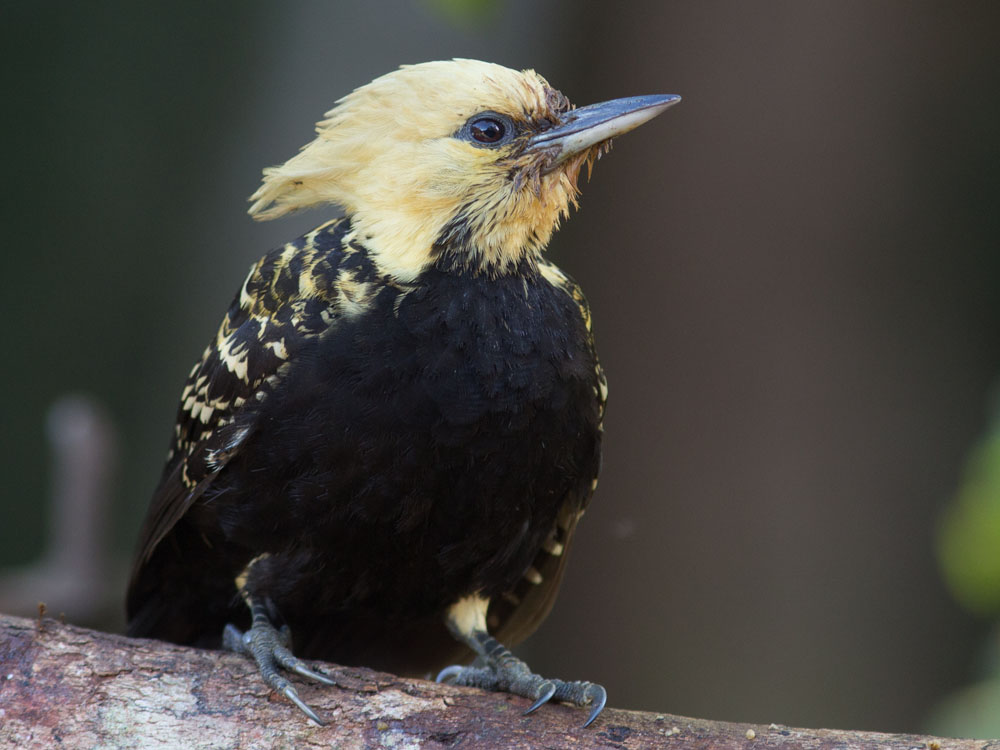
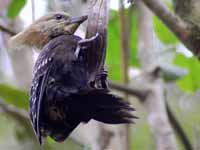
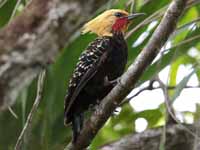
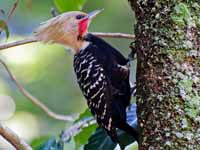
Woodpecker,_Chestnut Celeus elegans
Description: The chestnut woodpecker has mainly chestnut plumage. It has a yellow rump and flanks, The tail is black, the bill yellow, and it has light eye-rings. The male has a red malar stripe. It is similar to the scale-breasted woodpecker which has a patterned breast while the chesnut woodpecker has a plain breast. The chestnut woodpecker is about 28 cm long and 125 grams. The nest cavity is in a dead tree, with the chamber floor up to 30 cm below the entrance.
Range: Central and northern South America. Also Trinidad.
Habitat: Rainforest, seasonally flooded forest, mangrove woodland, swamps, plantations and wooded savannah.
Diet: Ants, termites, their larvae. Also fruit. It forages in trees.
Conservation status: Least Concern.
Image by: 1) Steve Garvie - Trinadad 2) Francesco_Veronesi - Trinidad 3) Joao_Quental - BrazilRange: Central and northern South America. Also Trinidad.
Habitat: Rainforest, seasonally flooded forest, mangrove woodland, swamps, plantations and wooded savannah.
Diet: Ants, termites, their larvae. Also fruit. It forages in trees.
Conservation status: Least Concern.
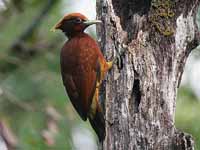
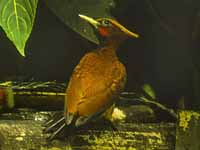
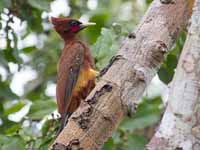
Woodpecker,_Chestnut-colored Celeus castaneus
Description:The chestnut-colored woodpecker has mainly dark rufous plumage with black chevrons. It has a lighter chestnut head with a substantial creast and a pale yellow bill. The male has a red malar stripe. The similar cinnamon woodpecker has lighter underparts with thick dark barring. The chestnut-colored woodpecker is about 23 cm long and 80 to 100 grams,
Range: Southern Mexico through Central America to Panama.
Habitat: Subtropical or tropical moist lowland forests. It prefers the edges and clearings. Also mangroves.
Diet: Mainly ants and termites; also other insects, fruit.
Conservation status: Least Concern.
Image by: 1, 2) Doug_Greenberg - Costa Rica 3) George_Lin - Costa Roca Range: Southern Mexico through Central America to Panama.
Habitat: Subtropical or tropical moist lowland forests. It prefers the edges and clearings. Also mangroves.
Diet: Mainly ants and termites; also other insects, fruit.
Conservation status: Least Concern.
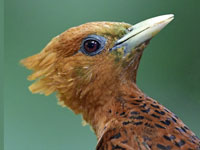
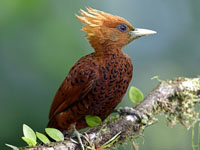
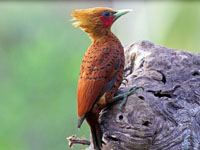
Woodpecker,_Cinnamon Celeus loricatus
Description: The cinnamon woodpecker has (cinnamon) rufous upperparts with thin black chevrons, a cinnamon crest, light underparts with black chevrons barring, and pale yellow bill. The male has a black and red chin and malar area. The cinnamon woodpecker is 19 to 23 cm long and 75 to 85 grams. The pair excavates a nest cavity in with a living or dead tree. It is similar to the chestnut-colored woodpecker, but has lighter underparts with thicker dark barring than does the chestnut-colored. The similar waved woodpecker has bolder bars on its back than does the cinnamon woodpecker.
Range: Colombia, Costa Rica, Ecuador, Nicaragua, and Panama.
Habitat: Humid forests, their edges and clearings, second growth forests.
Diet: Mainly ants and termites; also other insects, fruit.
Conservation status: Least Concern.
Image by: 1) Dick Daniels - Panama 2) Charles_Sharp - Panama 3) HarmonyOnPlanetEarth - Panama 4) Nick_Athanas - EcuadorRange: Colombia, Costa Rica, Ecuador, Nicaragua, and Panama.
Habitat: Humid forests, their edges and clearings, second growth forests.
Diet: Mainly ants and termites; also other insects, fruit.
Conservation status: Least Concern.
2) Female 3, 4) Male


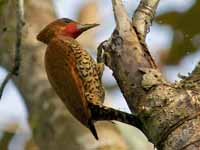
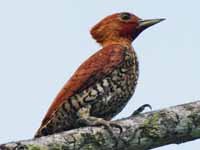
Woodpecker,_Cream-colored Celeus flavus
Description: The cream-colored woodpecker has mainly creamy yellow plumage with darker wingtips and a black tail. The male has a red malar stripe. The cream-colored woodpecker is 24 to 26 cm long.
Range: From Colombia, Venezuela and the Guianas to Peru, Bolivia, and the eastern part of Brazil.
Habitat: Rainforests, mangroves, forests near water, deciduous woodland as well as cacao plantations.
Diet: Mainly ants and termites; also other insects, seeds, fruit. Forages mainly in trees, but also on the ground.
Conservation status: Least Concern.
Image by: 1) Hector_Bottai - Brazil 2) Mark Watson - Venezuela 3) Joao Quental - Peru 4) Nick_Athanas - EcuadorRange: From Colombia, Venezuela and the Guianas to Peru, Bolivia, and the eastern part of Brazil.
Habitat: Rainforests, mangroves, forests near water, deciduous woodland as well as cacao plantations.
Diet: Mainly ants and termites; also other insects, seeds, fruit. Forages mainly in trees, but also on the ground.
Conservation status: Least Concern.
1, 2) Female 3, 4) Male

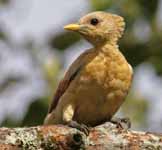
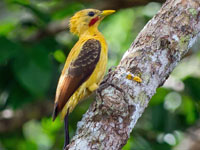
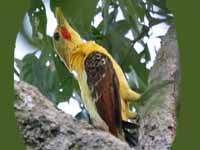
Woodpecker,_Helmeted Celeus galeatus
Description: The helmeted woodpecker has mainly brown-black upperparts, cream underparts with black barring, cinnamon colored head brightening to red on crown and crest. The helmeted woodpecker is 27 to 28 cm long. The male has more red on the malar region and also the chin. Nests are excavated in dead trees or dead parts of living trees.
Range: Northeastern Argentina, southeastern Brazil, and eastern Paraguay.
Habitat: Undisturbed forests; less often in disturbed forests.
Diet: Probably insects, their larvae; also fruit.
Conservation status: It is listed as Vulnerable with a declining population of less than 10,000 due to deforestation.
Image by: 1) Carlos_de_Almeida 2) Martjan_Lammertink 3) Tony_Morris - ParaguayRange: Northeastern Argentina, southeastern Brazil, and eastern Paraguay.
Habitat: Undisturbed forests; less often in disturbed forests.
Diet: Probably insects, their larvae; also fruit.
Conservation status: It is listed as Vulnerable with a declining population of less than 10,000 due to deforestation.
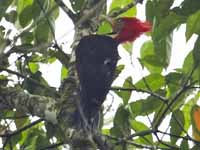

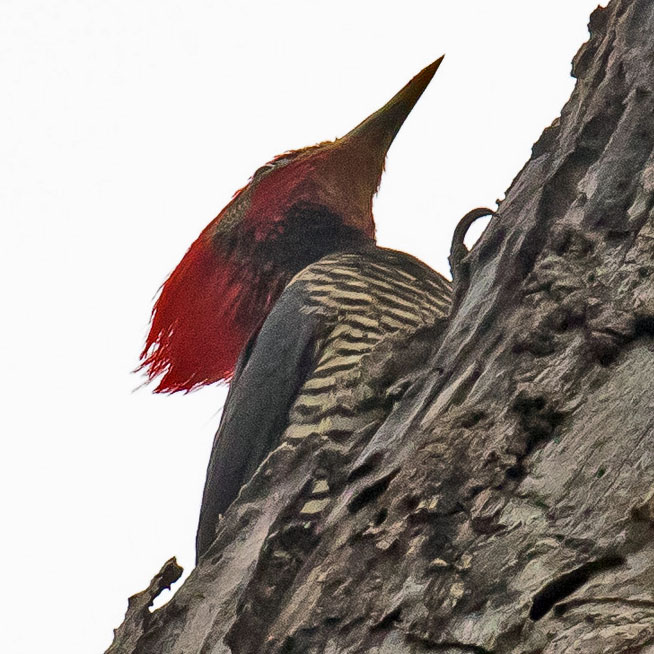
Woodpecker,_Kaempfer's Celeus obrieni
Description: The Kaempher's woodpecker has buff upperparts and also buff wing coverts that are barred with black. The head is red. The male has an even brighter red malar stripe, but it can be hard to notice. Ih has a black upper-breast with a little barring below the black area. The rest of the underparts are yellowish-buff. The Kaempher's woodpecker is 26 to 28 cm long.
Range: Brazil.
Habitat: Woodland with thickets of bamboo.
Diet: Mainly ants which obtains while foraging on bamboo or trees.
Conservation status: It is listed as Vulnerable. It is seen extremely infrequently - decades have sometimes gone between viewings.
Image by: 1) Joao_Quental 2) Cornell_Univ's_Neotropical_Birds_Online - Alex_MesquitaRange: Brazil.
Habitat: Woodland with thickets of bamboo.
Diet: Mainly ants which obtains while foraging on bamboo or trees.
Conservation status: It is listed as Vulnerable. It is seen extremely infrequently - decades have sometimes gone between viewings.
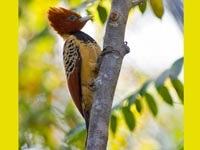
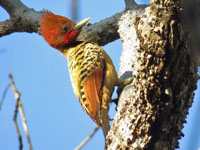
Woodpecker, Ochre-backed Celeus ochraceus
Description: The ochre-backed woodpecker has yellowish-tan upperparts with black marks. The head, including the long point crest, are ochre-colored (yellow or orangish tan). The male has a broad red malar stripe. The underparts are mainly black. The ochre-backed woodpecker is 25 to 27 cm long. It used to be considered a subspecies of the blond-crested woodpecker.
Range: Eastern Brazil.
Habitat: Rainforest, forest edge, wooded savannah, orchards and gardens.
Diet: Ants, termites, their larvae. Also fruit. It forages mainly in trees, but will come to the ground to look for insects.
Conservation status: Least Concern.
Image by: 1) Hector_Bottai - Brazil 2) Dario_Sanches - BrazilRange: Eastern Brazil.
Habitat: Rainforest, forest edge, wooded savannah, orchards and gardens.
Diet: Ants, termites, their larvae. Also fruit. It forages mainly in trees, but will come to the ground to look for insects.
Conservation status: Least Concern.
1) Female 2) Male
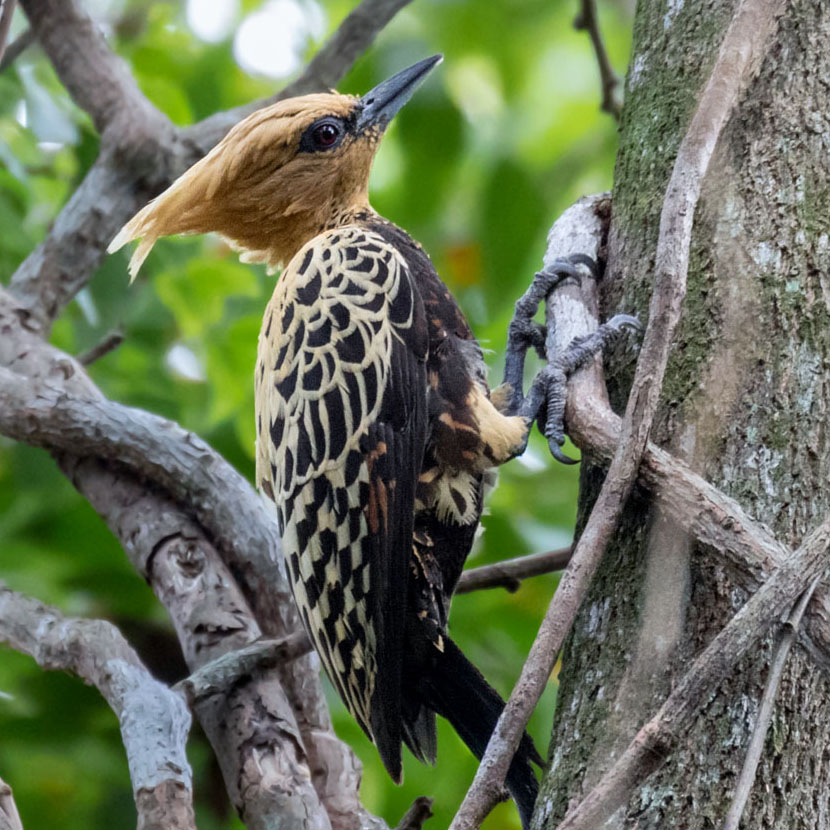
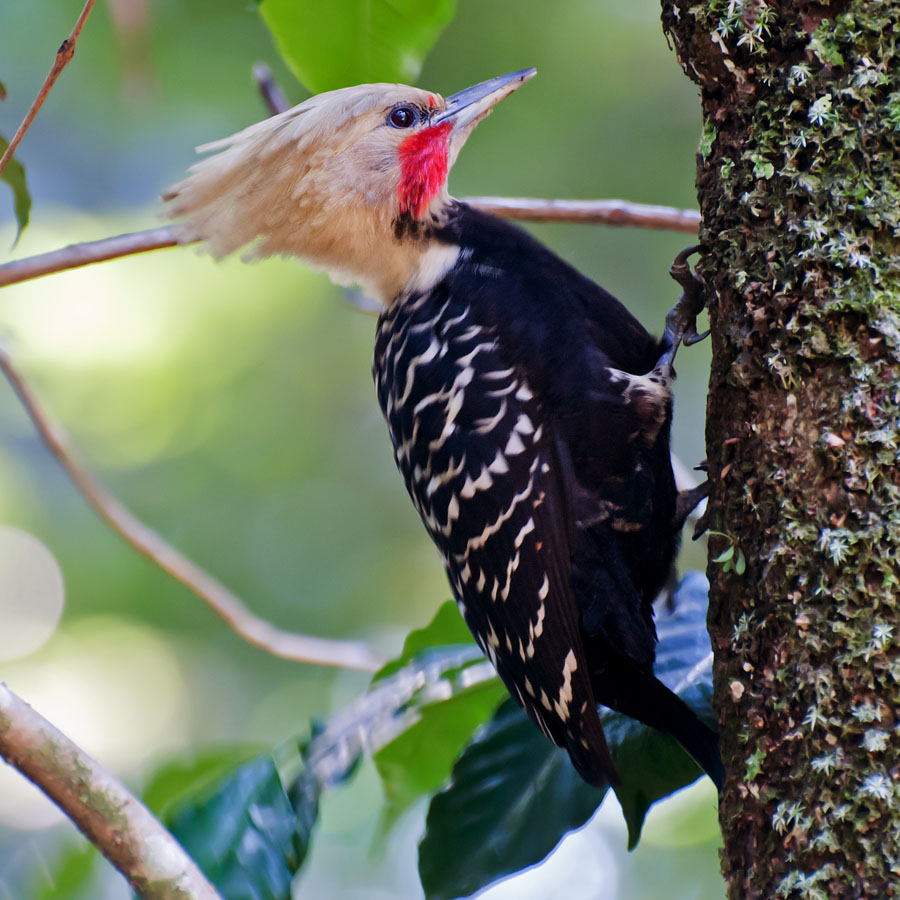
Woodpecker,_Pale-crested Celeus lugubris
Description: The pale-crested woodpecker has a pale-yellow crested head, dark brown or black upperparts with yellow bars, and dark brown underparts with some barring. The male has a red malar stripe mostly bordered by buff, whitle the female has a brown malar stripe which extends onto the face. The pale-crested woodpecker is 23 to 24 cm long. The similar female blond-crested woodpecker has a negligible malar stripe while the female pale-crested woodpecker hasa brown malar stripe, Differentiating between males is problematic, but in general the blond-crested woodpecker has stronger bar-like edging on its back.
Range: Central Bolivia, southwestern Brazil, central Paraguay and the border region of northern Argentina.
Habitat: Varied forests and woodlands.
Diet: Mainly ants which it captures in trees by pecking and gleaning.
Conservation status: Least Concern.
Image by: 1) Tambako The Jaguar 2) David Schenfeld - Brazil 3) Amelia_Berti - Paraguay Range: Central Bolivia, southwestern Brazil, central Paraguay and the border region of northern Argentina.
Habitat: Varied forests and woodlands.
Diet: Mainly ants which it captures in trees by pecking and gleaning.
Conservation status: Least Concern.
1, 2) Female 3) Male
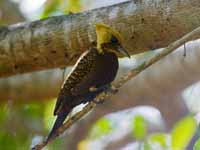
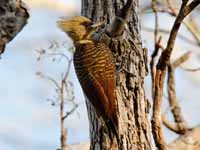
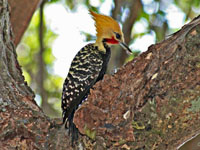
Woodpecker,_Ringed Celeus torquatus
Description: The ringed woodpecker has a cinnamon head and neck.The upperparts and tail are light chestnut with a few black dots or blackish bars depending on the subspecies. The throat and upper-breast are black. The rest of the underparts are white or cinnamon with black bars. The male has a broad red malar region. The ringed woodpecker is 26 to 28 cm long. The similar rufous-headed woodpecker has lighter upperparts than the chestnut of the ringed woodpecker.
Range: Northern South America - northern Brazil, French Guiana, Guyana, Suriname, and western Venezuela.
Habitat: Moist forests, woodlands, clearings, and forest edges.
Diet: Mainly ants; also termites, seeds, fruit.
Conservation status: It is listed as Least Concern to Vulnerable depending on the subspecies. As is true for many species of birds, deforestation is a challenge.
Image by: 1) Sean McCann - French Guiana 2) Nick_Athanas - Brazil 3) Hector_Bottai - BrazilRange: Northern South America - northern Brazil, French Guiana, Guyana, Suriname, and western Venezuela.
Habitat: Moist forests, woodlands, clearings, and forest edges.
Diet: Mainly ants; also termites, seeds, fruit.
Conservation status: It is listed as Least Concern to Vulnerable depending on the subspecies. As is true for many species of birds, deforestation is a challenge.
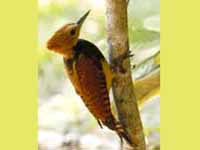
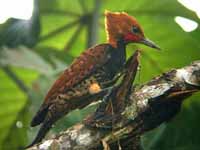
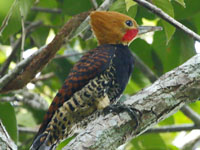
Woodpecker,_Rufous-headed Celeus spectabilis
Description: The rufous-headed woodpecker has a black back with yellow barring. The rump is yellowish as are the upper-tail coverts. The head and crest are mainly rufous-brown. The male has a broad crimson patch on the cheeks which the female lacks. It has a yellowish nape and dark brown throat. The upper-breast is black while the lower-breast and the rest of the underparts and flanks are yellow or cream with black markings. It has an ivory or yellowish bill and the legs are grey. The rufous-headed woodpecker is 26 to 28 cm long.The similar ringed woodpecker has darker upperparts than rufous-headed woodpecker.
Range: From Ecuador and Peru to northern Bolivia and westernmost Brazil.
Habitat: Humid forests and bamboo thickets; especially near streams and rivers.
Diet: Ants and other insects. It often forages on bamboo for ants. It also forages in trees and on fallen logs.
Conservation status: Least Concern.
Image by: 1) Yuri Hooker 2) Joao_Quental - BrazilRange: From Ecuador and Peru to northern Bolivia and westernmost Brazil.
Habitat: Humid forests and bamboo thickets; especially near streams and rivers.
Diet: Ants and other insects. It often forages on bamboo for ants. It also forages in trees and on fallen logs.
Conservation status: Least Concern.
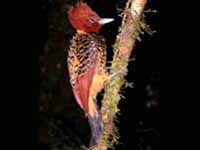
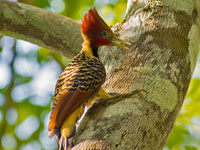
Woodpecker,_Scale-breasted Celeus grammicus
Description: The scale-breasted woodpecker has barred (scaly) chestnut upperparts and breast. It has a chestnut head which sometimes has dark streaks, yellowish-brown flanks, and light eye-rings. The belly is also chestnut, but lighter and less barred than the breast. It is similar to the chestnut woodpecker which does not have barring. The scale-breasted woodpecker is 22 to 26 cm long and 65 to 85 grams.
Range: Northern South America - Bolivia, Brazil, Colombia, Ecuador, French Guiana, Peru, and Venezuela.
Habitat: Moist forests, more open woodlands, treed savannas.
Diet: Mainly ants; also other insects, fruit.
Conservation status: Least Concern.
Image by: 1) Hector_Bottai - Brazil 2) Claudio_D_Timm Range: Northern South America - Bolivia, Brazil, Colombia, Ecuador, French Guiana, Peru, and Venezuela.
Habitat: Moist forests, more open woodlands, treed savannas.
Diet: Mainly ants; also other insects, fruit.
Conservation status: Least Concern.
1) Female 2) Male
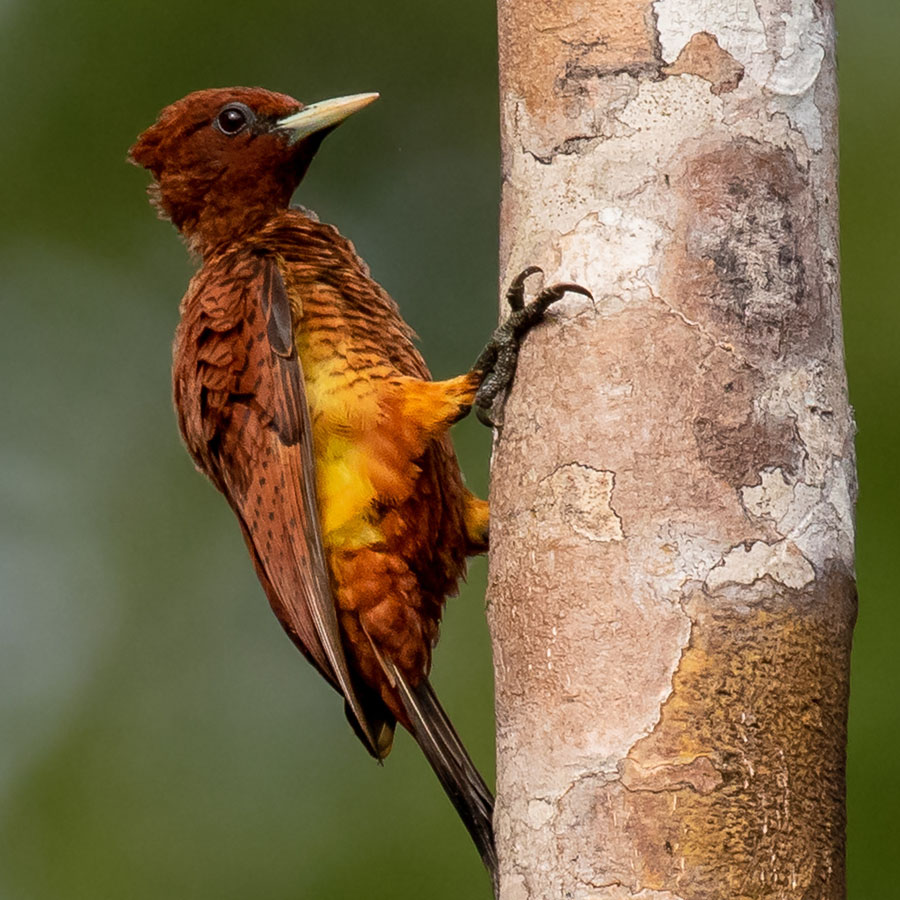
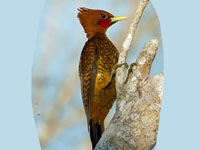
Woodpecker,_Waved Celeus undatus
Description: The waved woodpecker has mainly upperparts with bold wavy dark bars. The head is cinnamon. The male has bright red cheeks, while the female lacks any red facial coloring The waved woodpecker is about 23 cm long. It has bolder bars on its back than does the similar cinnamon woodpecker.
Range: Northern South America: Brazil, French Guiana, Guyana, Suriname, Venezuela.
Habitat: Lowland rainforest, mostly below 1,000 m, secondary forest and forest margins.
Diet: Mainly ants and termites; also fruit and seeds.
Conservation status: Least Concern.
Image by: 1) Jerry Oldenettel - Venezuela 2) Nick_Athanas - Venezula 3) Michel_Giraud-Audine - French Guiana Range: Northern South America: Brazil, French Guiana, Guyana, Suriname, Venezuela.
Habitat: Lowland rainforest, mostly below 1,000 m, secondary forest and forest margins.
Diet: Mainly ants and termites; also fruit and seeds.
Conservation status: Least Concern.
2) Female 3) Male
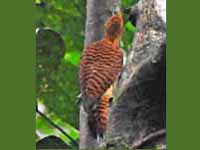
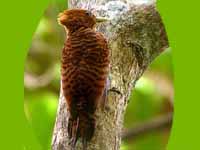
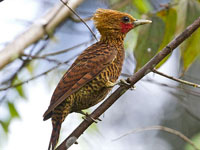
Genus Piculus
Woodpecker,_Golden-green Piculus chrysochloros
Description: The golden-green woodpecker has green upperparts. The male has a red crown and malar stripe while on the female these are green. From the lores to the neck there is a yellow stripe. It has light green underparts with darker green barring. The golden-green woodpecker subspecies vary considerably in size from 18 to 27 cm in length. They may be split into distinct species.
Range: Northern 2/3 of South America.
Habitat: Forests, their edges and clearing, woodlands, wooded savanna.
Diet: Mainly ants and termites. Forages in trees by gleaning and pecking.
Conservation status: Least Concern.
Image by: 1) Ron Knight 2) Andrea_Ferreira - Paraguay 3) Nick_Athanas - BrazilRange: Northern 2/3 of South America.
Habitat: Forests, their edges and clearing, woodlands, wooded savanna.
Diet: Mainly ants and termites. Forages in trees by gleaning and pecking.
Conservation status: Least Concern.
3) Male
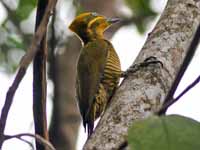
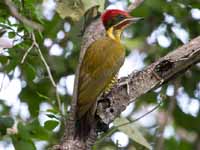
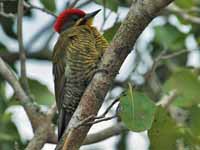
Woodpecker,_Lita Piculus litae
Description: The Lita woodpecker has a large yellow facial patch. The male a red forehead, crown, nape, and malar stripe. For the female, the crown forehead and crown are yellow, the nape and malar stripe are red. It has bronze-green upperparts. The underparts has blackish and white spots, except the upper-breast is red with white spots. The Lita woodpecker is 17 to 18 cm long.
Range: Western Columbia, northwest Ecuador.
Habitat: Lowland forests and their edges.
Diet: Probably insects. It forages in trees.
Conservation status: Least Concern.
Image by: 1) Luis_UruenaRange: Western Columbia, northwest Ecuador.
Habitat: Lowland forests and their edges.
Diet: Probably insects. It forages in trees.
Conservation status: Least Concern.

Woodpecker,_Rufous-winged Piculus simplex
Description: The rufous-winged woodpecker has olive-green upperparts with inconspicuous rufous on the wings. The males head, including a broad malar stripe, is mostly red except for brownish-green ear-coverts. On the female the red is limited to the nape, elsewhere the red is replaced by brownish-green. It has a green throat, green upper-breast with yellowish marks; the rest of the underparts are pale dark with green barring. It has a black bill with pale grey base. The rufous-winged woodpecker is about 18 cm and 50 to 55 grams.
Range: Caribbean coast from Honduras to Panama.
Habitat: Humid forests and their edges; also more open areas with tall trees available.
Diet: Ants, beetles, and their larvae. Forages in trees.
Conservation status: Least Concern.
Image by: 1) Jerry Oldenettel - Costa Rica 2) Steve Garvie - NicaraguaRange: Caribbean coast from Honduras to Panama.
Habitat: Humid forests and their edges; also more open areas with tall trees available.
Diet: Ants, beetles, and their larvae. Forages in trees.
Conservation status: Least Concern.
2) Male
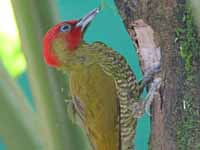
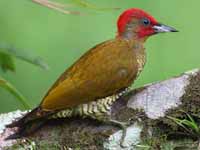
Woodpecker,_Stripe-cheeked Piculus callopterus
Description: The stripe-cheeked woodpecker has olive-green upperparts, an off-white cheek stripe, and white spotted underparts. The male has a red crown, nape, and malar stripe; on the female the red is replaced with dark grey. The bill is black with the lower mandible base colored grey. The stripe-cheeked woodpecker is about 17 cm long.
Range: Panama.
Habitat: Humid forests and their edges.
Diet: It mainly eats ants and forages in trees.
Conservation status: Least Concern.
Image by: 1) Nick_Athanas - Panama 2) HarmonyOnPlanetEarth - Panama 3) Dave_CurtisRange: Panama.
Habitat: Humid forests and their edges.
Diet: It mainly eats ants and forages in trees.
Conservation status: Least Concern.
2) Female
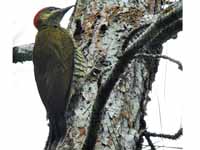
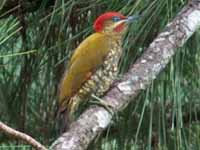
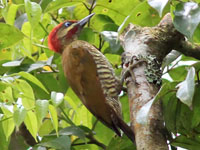
Woodpecker,_White-throated Piculus leucolaemus
Description: The white-throated woodpecker has bronze-green upperparts with blackish upper-tail that has green edges. The male has a mainly red head and nape including the malar region. It has a yellow band from the lores to the nape, the band widening as it approach the neck. The female's red area is limited to a small nape patch. They both have a white throat. The upper-breast is yellowish-green while the rest of the underparts are white with green bars. It is 19 to 20 cm long and about 70 grams.
Range: Mainly Ecuador, Peru, Bolivia; also Brazil.
Habitat: Forests, their edges, secondary growth.
Diet: Insects which it finds in trees.
Conservation status: Least Concern.
Image by: 1) Hector_Bottai - Brazil 2 )Joao_Quental - BrazilRange: Mainly Ecuador, Peru, Bolivia; also Brazil.
Habitat: Forests, their edges, secondary growth.
Diet: Insects which it finds in trees.
Conservation status: Least Concern.

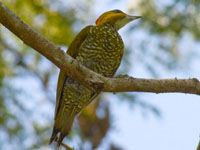
Woodpecker,_Yellow-browed Piculus aurulentus Found: South America
Description: The yellow-browed woodpecker, also known as the white-browed woodpecker, has olive-green upperparts and nape. The male has a red crown, nape, and malar stripe. The female replaces most of that red with green, except some red does remain for the malar stripe. The head has a whitish-yellow supercilium, and a similar colored stripe from the lores to behind the eyes. It has a golden chin and whitish underparts with dark barring. The yellow-browed woodpecker is 21 to 22 cm long and about 65 grams.
Range: Brazil, Argentina and Paraguay.
Habitat: Humid Forests, their edges, secondary growth.
Diet: Mainly ants, also fruit. It forages in trees by gleaning and pecking.
Conservation status: It is listed as Near Threatened because of deforestation.
Image by: 1) Hector_Bottai - Brazil 2) Gustavo_Forreque - Brazil 3) Cláudio Timm - Brazil 3)Range: Brazil, Argentina and Paraguay.
Habitat: Humid Forests, their edges, secondary growth.
Diet: Mainly ants, also fruit. It forages in trees by gleaning and pecking.
Conservation status: It is listed as Near Threatened because of deforestation.
1) Female 2, 3) Male
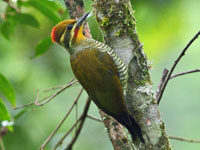
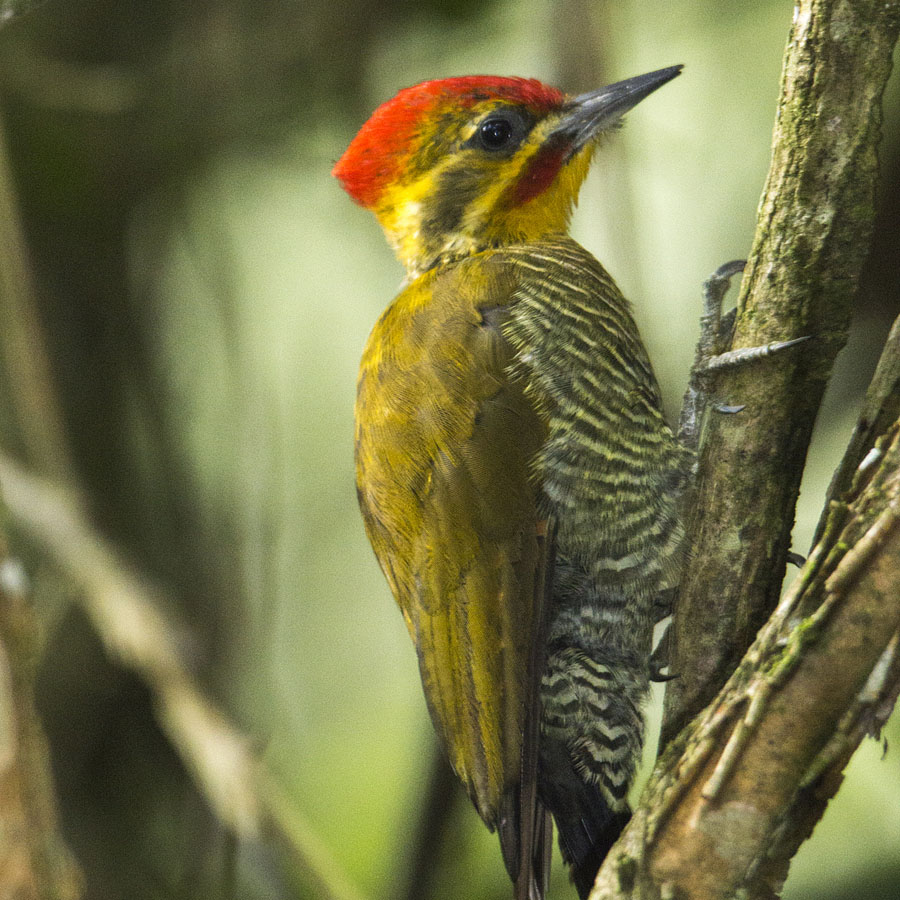
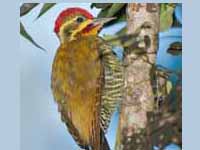
Woodpecker,_Yellow-throated Piculus flavigula
Description: The yellow-throated woodpecker has green upperparts and white underparts with green bars. The male has a red crown, nape, and malar stripe; the female has those areas mainly yellow. They both have a yellow throat. The yellow-throated woodpecker is 19 to 20 cm long and about 55 grams.
Range: Northern and central South America.
Habitat: Tropical and subtropical forests and swamps.
Diet: Mainly insects by foraging in trees.
Conservation status: Least Concern.
Image by: 1) Hector_Bottai - Braxzil 2) J_Quental 3) Nick_Athanas - BrazilRange: Northern and central South America.
Habitat: Tropical and subtropical forests and swamps.
Diet: Mainly insects by foraging in trees.
Conservation status: Least Concern.
1) Female 2, 3) Male
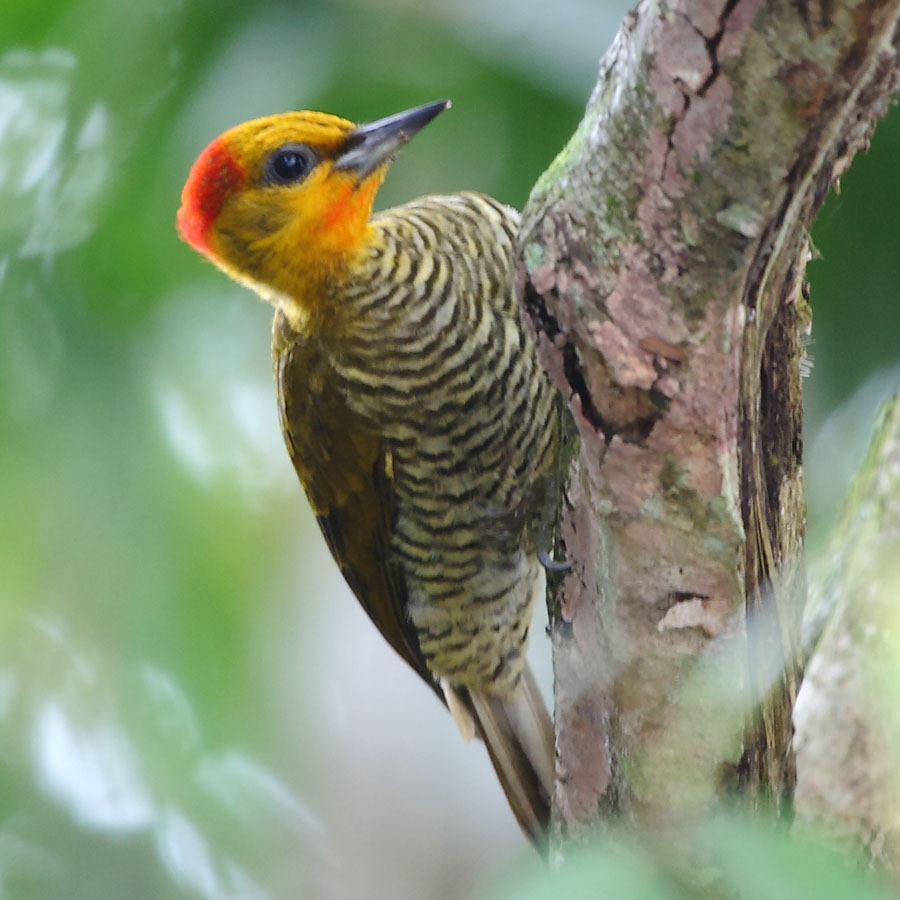
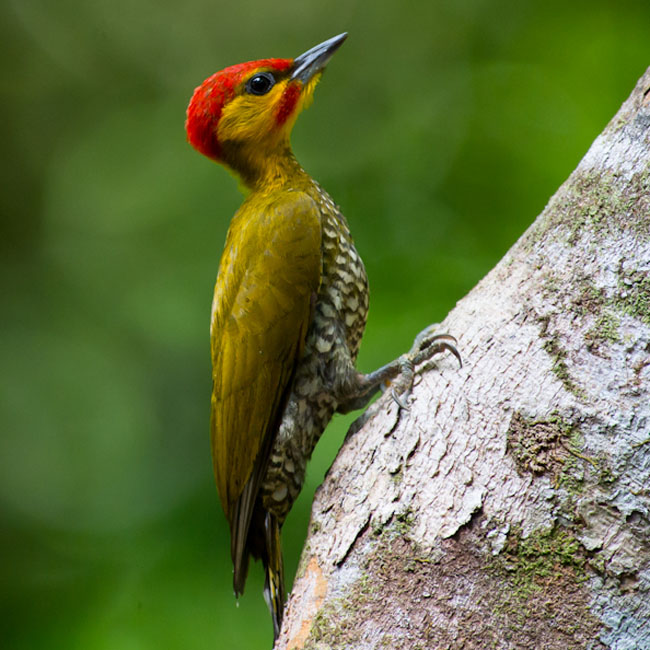

Genus Veniliornis Found : South America
Woodpecker,_Bar-bellied Veniliornis nigriceps
Description: The bar-bellied woodpecker has dark green upperparts with a bronze tinge. The male has a red crown to nape while for the female the red is replace with black. It has a narrow white supercilium and similarly for a malar stripe. It has
strongly barred underparts. Some subspecies have black bars on white background, others have thinner bars on a green background. The male has a red crown, female has black or grey crown. The bar-bellied woodpecker is 17 to 20 cm long and weighs about 45 grams.
Range: Bolivia, Columbia, Ecuador, Peru.
Habitat: Subtropical or tropical moist montane forests.
Diet: Probably insects for which it forages in trees.
Conservation status: Least Concern.
Image by: 1) Ron Knight - Columbia 2) Nick_Athanas - Ecuador 3) Francesco_Veronesi - EcuadorRange: Bolivia, Columbia, Ecuador, Peru.
Habitat: Subtropical or tropical moist montane forests.
Diet: Probably insects for which it forages in trees.
Conservation status: Least Concern.
1, 2) Female 3) Male
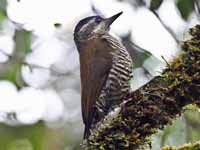

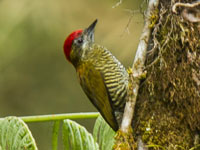
Woodpecker,_Blood-colored Veniliornis sanguineus
Description: The blood-colored woodpecker has crimson upperparts and nape which may have brown showing, especially on the lower back. There is a crimson (male) or brown (female) crown. The ear-coverts are light brown and often with some fine white streaks. The throat is also light brown, but with dark barring. It has white underparts with grey-brown barring. The blood-colored woodpecker is a small woodpecker with a length of about 13 cm and weight of 25 to 30 grams. The similar red-stained woodpecker has less red on the upperparts.
Range: Guyana, Suriname, and French Guiana near the Atlantic coast.
Habitat: Subtropical or tropical moist lowland forests, mangrove forests, and heavily degraded former forest.
Diet: Ants, beetles, and other small invertebrates. It mainly forages in the lower level of trees.
Conservation status: Least Concern.
Image by: 1, 2) Dave Curtas - Guyana Range: Guyana, Suriname, and French Guiana near the Atlantic coast.
Habitat: Subtropical or tropical moist lowland forests, mangrove forests, and heavily degraded former forest.
Diet: Ants, beetles, and other small invertebrates. It mainly forages in the lower level of trees.
Conservation status: Least Concern.
1) Female 2) Male
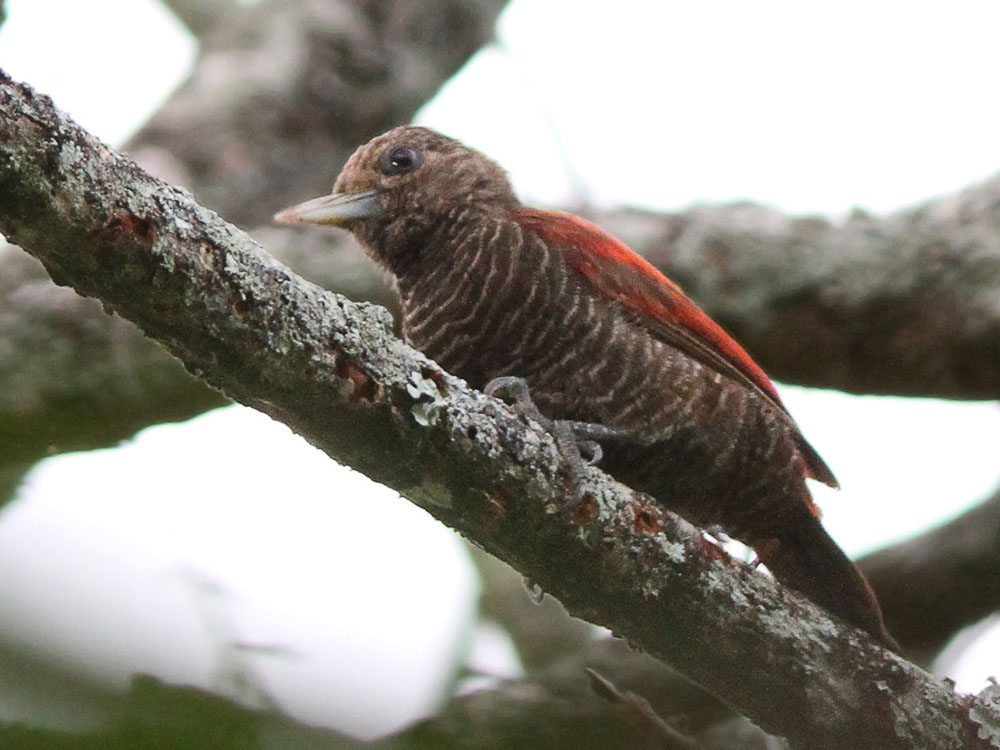

Woodpecker,_Checkered Veniliornis mixtus
Description: The checkered woodpecker has black-and-white checkered upperparts, a black crown with white dots, black nape, a white face with black eye-line, and whitish underparts with fine dark streaks. Male has red on its nape. The checkered woodpecker is 14 cm long and about 35 grams. The similar striped woodpeckers is larger than the checked woodpecker and has bolder underparts.
Range: Eastern South America.
Habitat: Woodland, treed savanna.
Diet: Mainly insects, also seeds. Forages in trees, but only pecks weakly.
Conservation status: Least Concern.
Image by: 1) Shanthanu Bhardwaj - Argentina 2) Ron Knight - Argentina 3) Nick_Athanas - ArgentinaRange: Eastern South America.
Habitat: Woodland, treed savanna.
Diet: Mainly insects, also seeds. Forages in trees, but only pecks weakly.
Conservation status: Least Concern.
3) Male
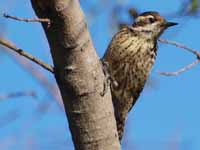

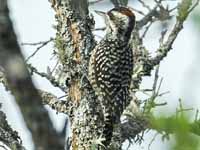
Woodpecker,_Choco Veniliornis chocoensis
Description: The Choco woodpecker has bronze-green upperparts wit a dark brown upper-tail. It has a olive-colored crown with a dull golden nape. The male has red feather tips on the head that are partially visible. The chin and ear-coverts are pale with thin darker markings. It has whitish underparts with dark green barring. The Choco woodpecker is about 15 cm and 30 grams.
Range: Columbia, Ecuador.
Habitat: Subtropical or tropical moist lowland forests.
Diet: Probably small insects.
Conservation status: It is listed as Near Threatened due to deforestation.
Image by: 1, 2) Nick_Athanas - Ecuador 3) George_CruzRange: Columbia, Ecuador.
Habitat: Subtropical or tropical moist lowland forests.
Diet: Probably small insects.
Conservation status: It is listed as Near Threatened due to deforestation.
1) Female 2, 3) Male

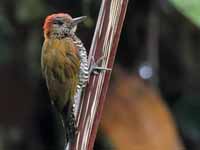

Woodpecker,_Dot-fronted Veniliornis frontalis
Description: The dot-fronted woodpecker has yellowish-olive upperparts with faint white spots. It has a grey-brown forehead with white spots. The head is greyish-brown also with some white spots. From the crown to the nape the male has red visible. The underparts are olive-grey with thin white bars. The dot-fronted woodpecker is about 16 cm long.
Range: Argentina, Bolivia.
Habitat: Humid montane forests on Andean slopes.
Diet: Insects captured on trees.
Conservation status: Least Concern.
Image by: 1) Ron_Knight - Argentina Range: Argentina, Bolivia.
Habitat: Humid montane forests on Andean slopes.
Diet: Insects captured on trees.
Conservation status: Least Concern.
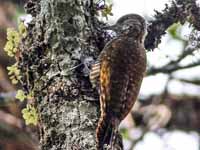
Woodpecker,_Golden-collared Veniliornis cassini
Description: The golden-collared woodpecker has yellowish-olive upperparts with some light spotting and a dark brown tail with some white bars. It has a golden nape, olive-brown ear-coberts and chin, and thin white malar stripe. The male has a red red crown. It has white underparts with olive-grey barring. The golden-collared woodpecker is 16 cm long.
Range: Northern Brazil, far eastern Colombia, the Guianas, Venezuela.
Habitat: Subtropical or tropical moist lowland forests.
Diet: Beetles, their larvae, and other insects.
Conservation status: Least Concern.
Image by: 1) Anselmo d'Affonseca Hector_Bottai - BrazilRange: Northern Brazil, far eastern Colombia, the Guianas, Venezuela.
Habitat: Subtropical or tropical moist lowland forests.
Diet: Beetles, their larvae, and other insects.
Conservation status: Least Concern.
1)Female 2) Male


Woodpecker,_Little Veniliornis passerinus
Description: The little woodpecker has yellowish green upperparts with a few light-colored shoulder spots, off-white underparts with grey barring, a grey crown (males has red rear-crown and nape). This little woodpecker is 12 to 14 cm long and only weighs about 19 grams. The similar red-rumped woodpecker has a red rump while the little woodpecker has an olive rump.
Range: East of the South American Andes.
Habitat: Scattered trees in dry areas.
Diet: Insects foraged in tress.
Conservation status: Least Concern.
Image by: 1, 2, 3)
Cláudio Timm - Rio Grande do Sul, BrazilRange: East of the South American Andes.
Habitat: Scattered trees in dry areas.
Diet: Insects foraged in tress.
Conservation status: Least Concern.
1, 2) Female 3) Male
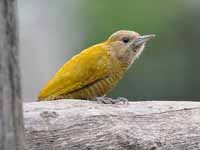
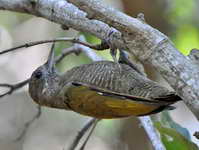
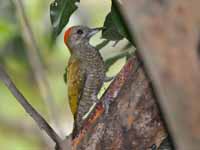
Woodpecker,_Red-rumped Veniliornis kirkii
Description: The red-rumped woodpecker has golden-olive upperparts, a red rump), buff-white underparts with dark brown barring,a blackish-brown tail, and a black bill. The forehead and and cheeks are buffy. The male has a dark brown crown and nape with red tips to the feathers, the red being more predominant on tha nape, while the female has a dark brown crown with no red. The red-rumped woodpecker is 15 to 16 cm long. The similar little woodpecker. has olive rump, not a red one.
Range: From Costa Rica south and east to Ecuador, Also the Caribbean *Trinidad and Tobago.
Habitat: Forests, more open woodland, and cultivation.
Diet: Mainly insects. It forages on trees.
Conservation status: Least Concern.
Image by: Cristobal Minic - Venezuela 2) Karla_Pérez_León - Venezuela 3) Albert_Michaud - Ecuador Range: From Costa Rica south and east to Ecuador, Also the Caribbean *Trinidad and Tobago.
Habitat: Forests, more open woodland, and cultivation.
Diet: Mainly insects. It forages on trees.
Conservation status: Least Concern.
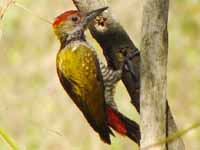
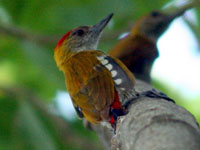

Woodpecker,_Red-stained Veniliornis affinis
Description: The red-stained woodpecker has olive upperparts with red-tinged wing coverts, a dark crown, dirty yellowish face, a yellowish nape with some red, and light underparts with dark brown barring. The male has a black crown with red tips to the feathers. For the female the crown is dark olive-brown with no red. They both have a golden rear-nape, The red-stained woodpecker is 16 to 18 cm long and 30 to 40 grams. The similar blood-colored has more red on the upperparts than does the red-stained woodpecker.
Range: Bolivia, Brazil, Colombia, Ecuador, Peru, and Venezuela.
Habitat: Subtropical or tropical moist lowland forest.
Diet: Insects, also fruit.
Conservation status: Least Concern.
Image by: 1) Hector_Bottai - Brazil 2) Nick_Athanas - BrazilRange: Bolivia, Brazil, Colombia, Ecuador, Peru, and Venezuela.
Habitat: Subtropical or tropical moist lowland forest.
Diet: Insects, also fruit.
Conservation status: Least Concern.
1, 2) Male
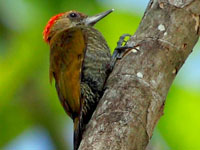
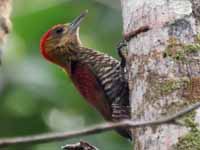
Woodpecker,_Scarlet-backed Veniliornis callonotus
Description: The scarlet-backed woodpecker has red upperparts, a whitish face, off-white underparts with faint bars, and pale bill. The male has a red-streaked black cap while the female has a black cap. The scarlet-backed woodpecker is small with a length of 13 cm and 25 to 35 grams.
Range: Columbia, Ecuador, Peru.
Habitat: Subtropical or tropical dry forests and dry shrubland.
Diet: Probably small insects.
Conservation status: Least Concern.
Image by: 1) Jorge_Montejo - Peru 2) Francesco_Verones 3) Nick_Athanas - Ecuador Range: Columbia, Ecuador, Peru.
Habitat: Subtropical or tropical dry forests and dry shrubland.
Diet: Probably small insects.
Conservation status: Least Concern.
1) Female top, male bottom 3) Male

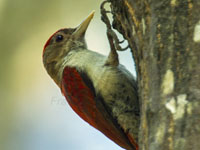
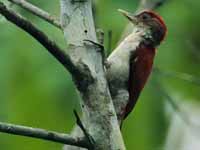
Woodpecker,_Striped Veniliornis lignarius
Description: The striped woodpecker has black upperparts with white barring. It has a black forehead and nape. The male has a red hind-crown. It has a white face with a black eye-line and black malar stripe. The underparts are white with black bars and streaks. The striped woodpecker is 15 to 16 cm long and weighs 35 to 40 grams. The similar checked woodpecker has bolder underparts; their ranges do not commonly overlap.
Range: Southwestern South America wuth an isolated population in Bolivia.
Habitat: Forests and their edges, open woodlands.
Diet: Mainly insects.
Conservation status: Least Concern.
Image by: 1) Eduardo_Schmeda 2) Ben Tubby 3) Elbocha60Range: Southwestern South America wuth an isolated population in Bolivia.
Habitat: Forests and their edges, open woodlands.
Diet: Mainly insects.
Conservation status: Least Concern.
1) Female 2, 3) Male
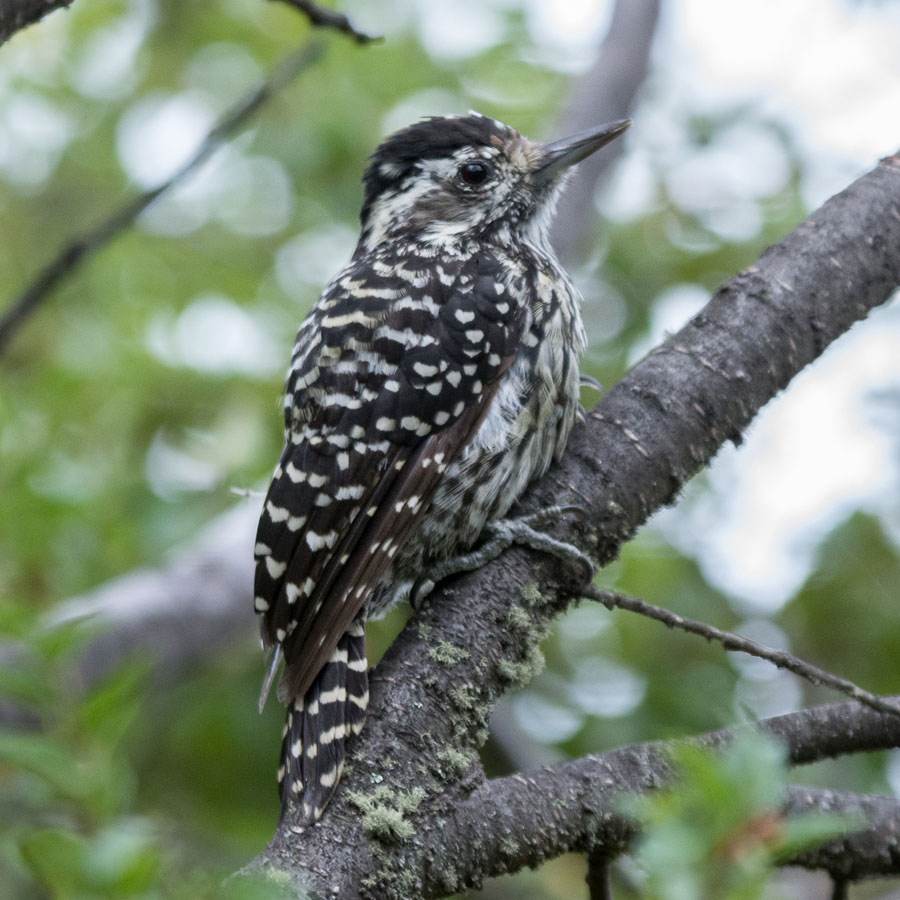
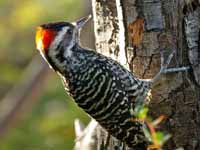
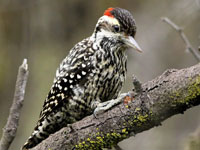
Woodpecker,_White-spotted Veniliornis spilogaster
Description: The white-spotted woodpecker has olive upperparts with yellowish markings. The white throat and neck are slightly streaked with black. It has black and white barred underparts. There is a light curvy line above and below a dark eye-line. The forehead is brown with the male having red steaks and the female white ones. The white-spotted woodpecker is 16 to 19 cm long. The similar yellow-eared woodpecker has a yellowish nape while the white-spotted woodpecker has a dark nape.
Range: Argentina, Brazil, Paraguay, and Uruguay.
Habitat: Varied from forests to open areas with spiny trees.
Diet: Insects, especially beetles and their larvae.
Conservation status: Least Concern.
Image by: 1, 2)
Cláudio Timm - Brazil 3) Juliano Kunze - Brazil 4) Aurea das Graças PC SilvaRange: Argentina, Brazil, Paraguay, and Uruguay.
Habitat: Varied from forests to open areas with spiny trees.
Diet: Insects, especially beetles and their larvae.
Conservation status: Least Concern.
1, 2) Male

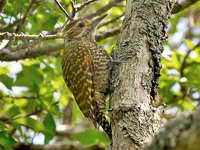
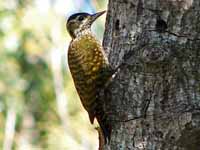
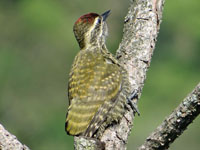
Woodpecker,_Yellow-eared Veniliornis maculifrons
Description: The yellow-eared woodpecker has dark olive upperparts with mottling and whitish underparts with grey barring. The male has a red crown while for the female it is black. They both have a yellowish nape (yellow-eared is misnomer) and a dark face. The yellow-eared woodpecker is about 15 cm long. The similar white-spotted woodpecker has a dark nape.
Range: Eastern Brazil.
Habitat: Humid Atlantic forests; also secondary forests, parks
Diet: Probably insects, maybe also fruit.
Conservation status: Least Concern.
Image by: 1, 2) Dario Sanches - Brazil 3) Carlos_HenriqueRange: Eastern Brazil.
Habitat: Humid Atlantic forests; also secondary forests, parks
Diet: Probably insects, maybe also fruit.
Conservation status: Least Concern.
3) Male


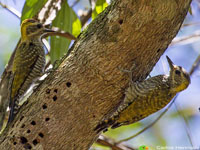
Woodpecker,_Yellow-vented Veniliornis dignus
Description: The yellow-vented woodpecker has olive upperparts and yellowish underparts with dark barring. It has a black throat and forehead. The face is light grey with a dark mask. The male has a red crown and nape while the female only has red on the nape. The yellow-vented woodpecker is 16 to 17 cm long and weighs 35 to 40 grams.
Range: Columbia, Ecuador, Peru, Venezuela.
Habitat: Humid montane forests and their edges.
Diet: Insects which it forages for in trees by pecking.
Conservation status: Least Concern.
Image by: 1) Nick_Athanas 2) Gary_Leavens - Ecuador 3) Patty_McGann - Ecuador 3) Nick_Athanas _ EcuadorRange: Columbia, Ecuador, Peru, Venezuela.
Habitat: Humid montane forests and their edges.
Diet: Insects which it forages for in trees by pecking.
Conservation status: Least Concern.
1, 2) Female 3, 4) Male
